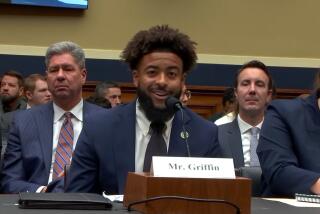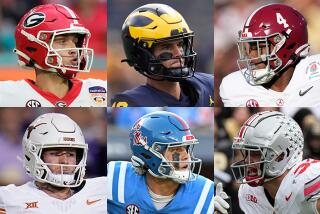Success, to Some Degree
If graduation rates were critical to the bowl championship series, neither Nebraska nor Miami would be playing in the Rose Bowl tonight.
If this purely academic standard were paramount, the title game might feature Duke and Northwestern. Or Rice and Stanford.
Those teams customarily graduate more than 80% of their players, according to a recent NCAA report. Yet, for the most part, they got nowhere near the top of the football rankings this season.
So thousands of fans in Pasadena and millions more watching on television will see teams representing programs that had no such success in the classroom. The Cornhuskers ranked 43rd among 111 Division I football programs with a graduation rate of 53%. The Hurricanes finished 76th at 41%.
“The subject of graduation rates needs to be raised every time we have a big game like this,” said Richard Lapchick, director emeritus of the Center for the Study of Sport in Society at Northeastern University. “It’s an important issue.”
It is also a complex issue that pits reform-minded critics against the athletic establishment, much of which argues that numbers don’t tell the whole story.
The debate heated up last summer when an independent panel recommended widespread changes to address “the widening chasm between higher education’s ideals and big-time college sports.”
The Knight Foundation Commission on Intercollegiate Athletics noted that only 48% of Division I football players earn degrees. The rate for African American players was 42%.
The commission recommended that, by 2007, teams should be required to graduate at least half of their players to qualify for postseason play, a rule that would have excluded Miami from the Rose Bowl, no matter how many games the Hurricanes had won.
“We’re not in the entertainment business; nor are we a minor league for professional sports,” Father Theodore Hesburgh, president emeritus of Notre Dame and commission co-chairman, said in June. “Your school is not worthy to be the champion of the country if you’re not educating your kids.”
That kind of talk irks coaches and administrators in athletic departments across the nation. The NCAA has previously said that 58% of student-athletes graduate, compared to 56% of all students. Besides, many say, the numbers are misleading.
Take Nebraska, for example. The Cornhuskers’ 53% rate suggests that one might look down the roster of 23 seniors and find that roughly half of them won’t finish school. In fact, only one is not on track to graduate. And one already has graduated. Quarterback Eric Crouch received his diploma last month. Another, tight end Tracey Wistrom, is an Academic All-American majoring in secondary education and mathematics.
“I could go down the line and tell you story after story,” said Dennis Leblanc, associate athletic director for academic and student services at the Lincoln campus.
So why the low rating?
Some players flunk out of school before their senior seasons. But Leblanc and others say the figures are deceiving because the NCAA uses limited information gathered by the U.S. Department of Education.
A player who leaves for any reason--homesickness, family problems--counts as a negative, even if he is an A student or eventually earns a degree elsewhere. Same goes for an athlete who transfers because he cannot make the starting lineup, a common occurrence at Nebraska and other major programs.
“I can’t graduate someone who’s not here,” Leblanc said. “If a kid transfers to Penn State, I can’t help him and he counts against us anyway.”
At Miami, where nine of 13 seniors already have graduated and offensive tackle Joaquin Gonzalez was nationally recognized for his academic achievement, an administrator points to another gap in the calculations. After a recent school year, four football players left early to turn professional. Those defections hurt the percentage.
“I would like a rate that is more reflective of students who leave in good academic standing,” assistant athletic director Tomas Jimenez said.
Jimenez is not alone. Years ago, quarterback Jeff Hostetler transferred from Penn State to West Virginia, eventually graduating as an Academic All-American. Penn State complained about his counting against its rate and the now-defunct College Football Assn. devised a measurement that accounts for student-athletes who transfer and eventually earn their degrees.
The formula also gives credit for players who come to a program after two years in junior college, a group the NCAA ignores. This method--now used by the American Football Coaches Assn.--puts the Division I football graduation rate at around 60%.
“We feel this gives a more balanced view,” AFCA official Chuck Neinas said.
Critics are not impressed.
The Knight Commission says student-athletes should be compared not to the general student body but to a smaller subset that, like athletes, enrolls immediately after high school. That group graduates at a rate of about 75%. Lapchick believes football players should do even better because they receive special tutoring.
“Unlike the general population, we’re bringing these students to a college campus to perform services for the school,” said Lapchick, who, come September, will chair the new DeVos Sports Business Management Program at the University of Central Florida. “We owe them a little bit more.”
Players acknowledge they have advantages.
“We have so much academic support with tutors and advisors and things like that, you almost have to try not to do well,” Nebraska’s Wistrom said.
Yet some of the best teams in the nation rank among the worst when it comes to graduation rates, according to the Chronicle of Higher Education, which analyzes NCAA statistics each year. The most recent reports showed only 36% of Oklahoma players finished school. Georgia Tech, Ohio State and Texas A&M; had 33% rates.
(Local schools fared better: USC ranked 15th in the nation at 65% and UCLA was 27th with a 59% rate.)
Meanwhile, critics point to instances of football programs altering grades, doing schoolwork for players--as occurred recently at USC--or guiding athletes into easy classes.
“The historic and vital link between playing field and classroom is all but severed in many institutions,” the Knight Commission stated.
Miami is fighting an image problem that dates to the 1980s, when football players came under scrutiny for alleged brushes with campus police, illegal use of telephone access cards and improper use of automobiles. The Hurricanes are especially sensitive about their academic reputation since Donna Shalala, former secretary of Health and Human Services, became president.
At Nebraska, administrators also worry that the public dismisses the school as a football factory.
Leblanc said, “That’s one of those arguments, like the BCS, you can’t win.”
Ironically, Lapchick cites the Cornhuskers as an example of a team working to make things right. The athletic department tries to keep players in school after their football careers have ended. Often, such players end up counting against the rate because they don’t finish in the required six years but, Leblanc said, “They are success stories.”
The Knight Commission and others have applauded such efforts and are hoping that stricter NCAA eligibility standards, enacted in the mid-1990s, will boost academic success in coming years. But they see much room for improvement.
In addition to recommending that graduation rates be a prerequisite for postseason play, the commission stated that if a player flunks out, his scholarship should be frozen until his freshman class graduates. The panel also would like to see the NCAA mainstream student-athletes, putting them through the same admissions processes as other students.
That raises the prickly question of whether student-athletes with poor high school records should be given chances at a college education.
“It might be, the world’s most brilliant violinist has lousy SATs,” Shalala said. “I want to be careful about singling out student-athletes when universities are doing all sorts of things ... for other kinds of admits.”
But Shalala does not want such admissions to come at the expense of academic standards. And though Jimenez, her assistant athletic director, thinks the Miami football team gets an unfair rap, he sees a benefit to public scrutiny of his and other teams.
Graduation rates are something to keep in mind, he believes, when people are watching the Rose Bowl tonight.
“It’s OK to have public pressure,” he said. “That pushes us to do the right thing. That’s a big part of changing the reputation.”
(BEGIN TEXT OF INFOBOX / INFOGRAPHIC)
Graduation Rates
Division I-A football players, 2001:
Duke...89%
Northwestern...86%
Rice...85%
Stanford...83%
Boston...78%
Tulane...76%
Vanderbilt...76%
Notre Dame...74%
Baylor...72%
Syracuse...72%
Virginia...72%
Indiana...70%
Penn State...70%
Southern Methodist...70%
USC...65%
Wake Forest...65%
Iowa...64%
Mississippi...64%
Arizona...63%
Bowling Green...62%
Western Michigan...62%
Mississippi State...61%
Ohio...61%
Oregon...61%
Hawaii...60%
Central Michigan...59%
UCLA...59%
North Carolina...59%
Toledo...59%
Georgia...58%
Clemson...57%
Purdue...57%
South Carolina...57%
Alabama...56%
Ball State...55%
Miami (Ohio)...55%
Washington...55%
Louisiana Tech...54%
Illinois...54%
Texas...54%
Tulsa...54%
Florida State...53%
Nebraska...53%
Wisconsin...53%
North Carolina State...50%
Alabama-Birmingham...50%
East Carolina...49%
Kentucky...49%
Southern Mississippi...49%
Washington State...49%
California...48%
West Virginia...48%
Eastern Michigan...47%
Kansas State...47%
Memphis...47%
Florida...46%
Minnesota...46%
Utah State...46%
Virginia Tech...46%
Oregon State...45%
Colorado...45%
Michigan...45%
Pittsburgh...45%
Colorado State...44%
Iowa State...44%
Marshall...44%
Buffalo...43%
Texas Christian...43%
Arkansas State...42%
Texas Tech...42%
Kansas...42%
Tennessee...42%
Auburn...41%
Kent State...41%
Northern Illinois...41%
Miami...41%
THE REST
Utah 41%; Wyoming 41%; Louisiana State 40%; Michigan State 40%; Idaho 40%; Louisiana Monroe 39%; Maryland 39%; Arizona State 38%; New Mexico State 38%; Rutgers 38%.
Temple 38%; Central Florida 38%; Cincinnati 38%; Oklahoma State 37%; Missouri 37%; North Texas 37%; Oklahoma 36%; Georgia Tech 33%; Ohio State 33%; San Jose State 33%.
Texas A&M; 33%; New Mexico 33%; San Diego State 32%; Arkansas 30%; Texas El Paso 30%; Houston 29%; Louisville 29%; Fresno State 28%; Middle Tennessee State 27%; Louisiana Lafayette 27%
Nevada Las Vegas 26%; Nevada 24%; Akron 23%; Boise State; 22%; Brigham Young; 21%.
SOURCE: NCAA
More to Read
Go beyond the scoreboard
Get the latest on L.A.'s teams in the daily Sports Report newsletter.
You may occasionally receive promotional content from the Los Angeles Times.











